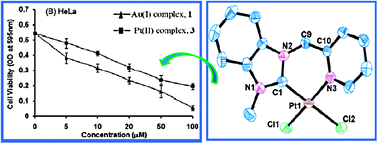Au(i)- and Pt(ii)-N-heterocyclic carbene complexes with picoline functionalized benzimidazolin-2-ylidene ligands; synthesis, structures, electrochemistry and cytotoxicity studies†
Abstract
Novel Au(I)-N-heterocyclic

* Corresponding authors
a School of Applied Science, “Applied Synthetic Chemical Research Lab.”, Haldia Institute of Technology, Haldia-721657, Purba Medinipur, West Bengal, India
b Department of Biochemistry, Indian Institute of Chemical Biology, Jadavpur, Kolkata-700032, West Bengal, India
c Department of Inorganic Chemistry, Indian Association for the Cultivation of Sciences, Jadavpur, Kolkata-700032, West Bengal, India
d Dipartimento di Chimica and Centro di Strutturistica Diffrattometrica, Universita' di Ferrara, Via L. Borsari, 46, Italy
Novel Au(I)-N-heterocyclic

 Please wait while we load your content...
Something went wrong. Try again?
Please wait while we load your content...
Something went wrong. Try again?
S. D. Adhikary, D. Bose, P. Mitra, K. D. Saha, V. Bertolasi and J. Dinda, New J. Chem., 2012, 36, 759 DOI: 10.1039/C2NJ20928D
To request permission to reproduce material from this article, please go to the Copyright Clearance Center request page.
If you are an author contributing to an RSC publication, you do not need to request permission provided correct acknowledgement is given.
If you are the author of this article, you do not need to request permission to reproduce figures and diagrams provided correct acknowledgement is given. If you want to reproduce the whole article in a third-party publication (excluding your thesis/dissertation for which permission is not required) please go to the Copyright Clearance Center request page.
Read more about how to correctly acknowledge RSC content.
 Fetching data from CrossRef.
Fetching data from CrossRef.
This may take some time to load.
Loading related content
